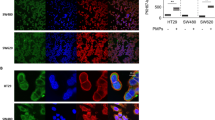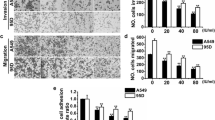Abstract
Metastasis of cancer cells is initiated by the cellular migration into extracellular matrix and surrounding vessels. We previously showed that elevation of cAMP levels in cancer cells suppressed trans-cellular migration in vitro. Drugs that can elevate cAMP levels in cancer cells effectively may be applied to prevent metastasis in cancer patients. Cilostazol, an oral anti-platelet drug, is a specific cAMP phosphodiesterase type III inhibitor and has been clinically used to treat thrombosis patients. In chemotaxis assay, cellular migration of human colon cancer cells, DLD-1, was induced by 10 μg/ml of soluble fibronectin or 10% of fetal bovine serum (FBS). Treatment with cilostazol (50 μM) suppressed 92.3% or 84.6% of the migration in control cells, respectively. When DLD-1 cells were stimulated by soluble fibronectin in phagokinetic assay, migration assessed by the area of gold particle phagocytosis track was induced and cilostazol also decreased 67.3% of the cellular migration in control cells. Furthermore, in the trans-cellular migration assay, cilostazol suppressed cancer cell invasion induced by FBS. Thus, cilostazol can suppress colon cancer cell motility and might be effective as an anti-metastasis drug for cancer patients.
Similar content being viewed by others
References
Midgley R, Kerr D. Colorectal cancer. Lancet 1999; 353: 391–9.
Imamura F, Horai T, Mukai M et al. Induction of in vitro tumor cell invasion of cellular monolayers by lysophosphatidic acid or phospholipase D. Biochem Biophys Res Commun 1993; 193: 497–503.
Mukai M, Imamura F, Ayaki M et al. Inhibition of tumor invasion and metastasis by a novel lysophosphatidic acid (cyclic LPA). Int J Cancer 1999; 81: 918–22.
Beavo JA, Conti M, Heaslip RJ. Multiple cyclic nucleotide phosphodiesterases. Mol Pharmacol 1994; 46: 399–405.
Sorkin EM, Markham A. Cilostazol. Drugs Aging 1999; 14: 63–71; discussion 72–3.
Welch DR, Lobl TJ, Seftor EA et al. Use of the Membrane Invasion Culture System (MICS) as a screen for anti-invasive agents. Int J Cancer 1989; 43: 449–57.
Albrecht-Buehler G. The phagokinetic tracks of 3T3 cells. Cell 1977; 11: 395–404.
Takaishi K, Kikuchi A, Kuroda S et al. Involvement of rho p21 and its inhibitory GDP/GTP exchange protein (rho GDI) in cell motility. Mol Cell Biol 1993; 13: 72–9.
Akedo H, Shinkai K, Mukai M et al. Interaction of rat ascites hepatoma cells with cultured mesothelial cell layers: a model for tumor invasion. Cancer Res 1986; 46: 2416–22.
Dawson DL, Cutler BS, Meissner MH, Strandness DE, Jr. Cilostazol has beneficial effects in treatment of intermittent claudication: Results from a multicenter, randomized, prospective, double-blind trial. Circulation 1998; 98: 678–86.
Ikeda Y, Matsumata T, Takenaka K et al. Effects of doxorubicin and/or cilostazol on cancer cells during liver regeneration after two-thirds hepatectomy in rats. Oncology 1998; 55: 354–6.
Tanaka K, Iwamoto Y, Ito Y et al. Cyclic AMP-regulated synthesis of the tissue inhibitors of metalloproteinases suppresses the invasive potential of the human fibrosarcoma cell line HT1080. Cancer Res 1995; 55: 2927–35.
Mokashi S, Delikatny SJ, Orr FW. Relationships between chemotaxis, chemotactic modulators, and cyclic nucleotide levels in tumor cells. Cancer Res 1983; 43: 1980–3.
Morton DM, Tchao R. Regulation of motility and cytoskeletal organization of rat bladder carcinoma cells by cyclic AMP. Cell Motil Cytoskeleton 1994; 29: 375–82.
Bianco C, Tortora G, Baldassarre G et al. 8–Chloro-cyclic AMP inhibits autocrine and angiogenic growth factor production in human colorectal and breast cancer. Clin Cancer Res 1997; 3: 439–48.
Murata J, Ayukawa K, Ogasawara M et al. Induction of autocrine factor inhibiting cell motility from murine B16–BL6 melanoma cells by alpha-melanocyte stimulating hormone. Int J Cancer 1999; 80: 889–95.
Ridgway AA, De Vouge MW, Mukherjee BB. Dibutyryl cAMP inhibits expression of transformation-related properties in Kirsten murine sarcoma virus transformed Balb/c-3T3 cells despite continued presence of p21v-Ki-ras. Biochem Cell Biol 1988; 66: 54–65.
Lee J, Choi YH, Nguyen P et al. Cyclic AMP induces inhibition of cyclin A expression and growth arrest in human hepatoma cells. Biochim Biophys Acta 1999; 1449: 261–8.
Takahashi S, Oida K, Fujiwara R et al. Effect of cilostazol, a cyclic AMP phosphodiesterase inhibitor, on the proliferation of rat aortic smooth muscle cells in culture. J Cardiovasc Pharmacol 1992; 20: 900–6.
Matousovic K, Grande JP, Chini CC et al. Inhibitors of cyclic nucleotide phosphodiesterase isozymes type-III and type-IV suppress mitogenesis of rat mesangial cells. J Clin Invest 1995; 96: 401–10.
Hinoda Y, Saito T, Takahashi H et al. Induction of nonspecific crossreacting antigen mRNA by interferon-gamma and anti-fibronectin receptor antibody in colon cancer cells. J Gastroenterol 1997; 32: 200–5.
Taylor R, Lee TD, Hoskin DW. Adhesion of tumoricidal eosinophils to MCA-38 colon adenocarcinoma cells involves protein tyrosine kinase activation and is diminished by elevated cyclic AMP in the effector cell. Int J Oncol 1998; 13: 1305–11.
Tortora G, di Isernia G, Sandomenico C et al. Synergistic inhibition of growth and induction of apoptosis by 8–chloro-cAMP and paclitaxel or cisplatin in human cancer cells. Cancer Res 1997; 57: 5107–11.
Author information
Authors and Affiliations
Rights and permissions
About this article
Cite this article
Murata, K., Kameyama, M., Fukui, F. et al. Phosphodiesterase type III inhibitor, cilostazol, inhibits colon cancer cell motility. Clin Exp Metastasis 17, 525–530 (1999). https://doi.org/10.1023/A:1006626529536
Issue Date:
DOI: https://doi.org/10.1023/A:1006626529536




